This wonderful Cornish workshop and museum is dedicated to the legacy of studio pottery trailblazer Bernard Leach
5 dragons for the Year of the Dragon
5 dragons for the Year of the Dragon
9 Feb 2024
On 10 February the Year of the Dragon begins again. To celebrate we bring you five dragon depictions that truly breathe fire
Calling all dragons: yes, that’s you, those born in 1928, 1940, 1952, 1964, 1976, 1988, 2000 or 2012.
It’s your time again. The Year of the Dragon is with us once more.
Considered one of the most desirable of all 12 zodiac years, it generally coincides with a marked uptick in births within countries or communities that honour the Chinese zodiac.
Dragons are themselves not limited to their connection with China and its diaspora, of course. Indeed, the appearance of dragons in almost all cultures – ancient and modern – has somewhat flummoxed scholars. Why are these similar mythological creatures found in so many places that had no connections to one another? Perhaps it’s because of the human instinct to fear snakes and other reptiles. Maybe it was due to the discovery of fossils that could not otherwise be explained.
Whatever the cause, dragons have made their mark everywhere, and art is no exception.
Here are just five of our favourite fire-breathing figures.
Fly the flag
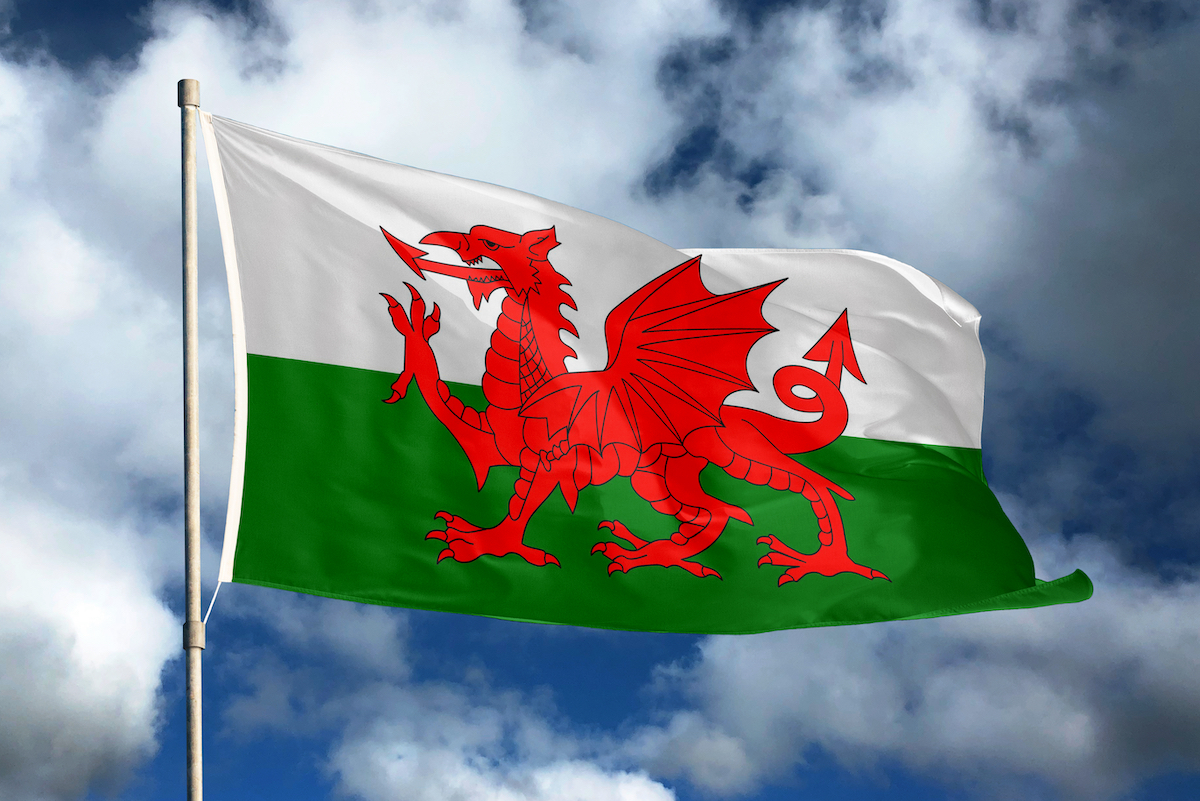 Flag of Wales, King Henry VII (1457–1509), c.1485. Image: Shutterstock
Flag of Wales, King Henry VII (1457–1509), c.1485. Image: Shutterstock
One of three possible flags that could appear on this list – as all good vexillologists would know, the other two are Bhutan and Malta – Wales’ national emblem has an interesting history.
The red dragon, fiery in colour against the green and white backdrop, was only officially adopted in 1959, but the design is based on a version that first appeared in the early years of the Tudors. A red dragon has been associated with Wales for much longer, possibly even since the early 5th century upon the Romans’ retreat, with Henry VII being credited as the first to add the green and white backdrop a millennia later.
As for why this long-standing emblem of Wales is absent from the Union Jack – which vexillologists may also know is officially the correct term, despite widespread belief that it is titled the Union Flag unless at sea – that is a question of timing. As Wales had already united with England at the time of the 1606 Union of the Crowns, it was felt that it didn’t merit its own mention.
Slay the dragon
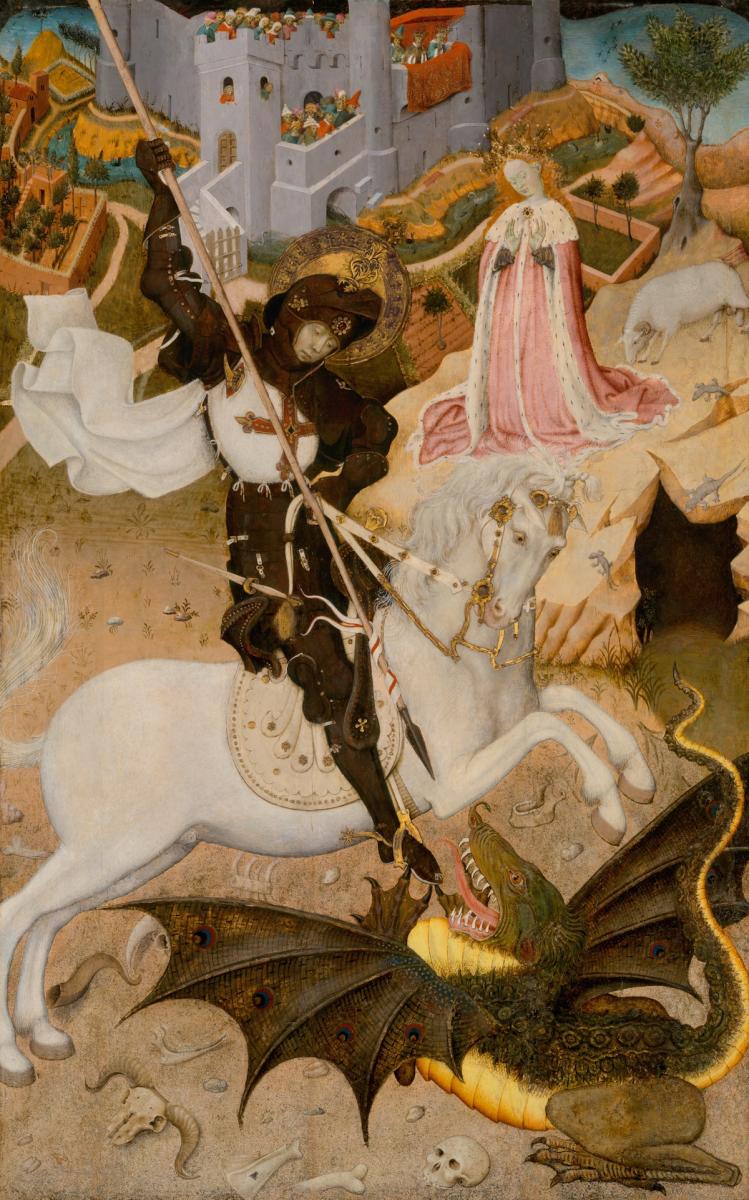 Caption: Saint George and the Dragon, Bernat Martorell (c.1400–52), 1434/35. Image: Art Institute Chicago/Gift of Mrs Richard E Danielson and Mrs Chauncey McCormick 1933.786
Caption: Saint George and the Dragon, Bernat Martorell (c.1400–52), 1434/35. Image: Art Institute Chicago/Gift of Mrs Richard E Danielson and Mrs Chauncey McCormick 1933.786
Though at first glance you may think we are sticking with the theme of British history, this rendition of the mighty Saint George’s victory over an evil dragon is firmly rooted in Catalonia.
Put to panel by Bernat Martorell, the region’s leading painter in the first half of the 15th century, the painting also includes a crowd watching on from a safe distance, an adoring princess and a smattering of other critters.
The familiar tale is here displayed in great Gothic style, deliberately bold to suit its placement at the centre of a Barcelona chapel. There’s a majesty and splendour to our central character, while his fearsome foe stretches upwards from the base of the scene. Four other panels appeared alongside this work, all of which can be found in Paris’ Louvre, some distance from the Art Institute of Chicago, which houses the central altarpiece.
For those with an interest in such things, St George is not only the patron saint of England – Catalonia, Ethiopia, Genoa, Portugal and Venice are among those to have claimed him too.
Smoky hues
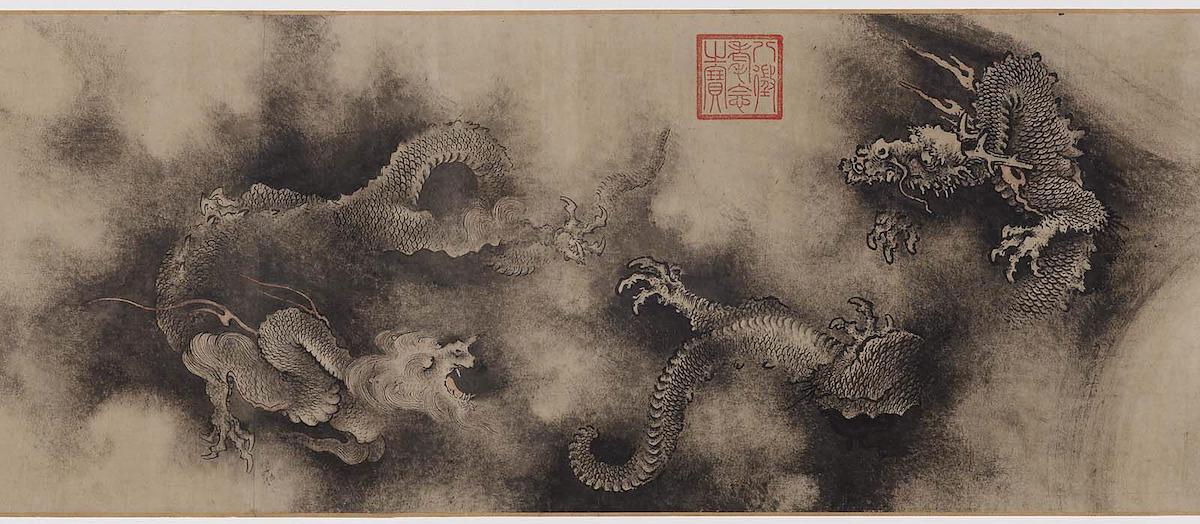 Nine Dragons, Chen Rong (1200–66), 1244. Image: Museum of Fine Arts Boston/Francis Gardner Curtis Fund 17.1697
Nine Dragons, Chen Rong (1200–66), 1244. Image: Museum of Fine Arts Boston/Francis Gardner Curtis Fund 17.1697
Fiery beasts that they are, the natural colour palette of dragon imagery is equally warm: rich reds, yellows, oranges and golds. Perhaps as a result, Chen Rong’s hand-scroll painting is a standout piece of historic Chinese art.
Clouded by smoke, we see dragons shifting and slinking through the monochromatic backdrop, some mostly shrouded from view. These particular creatures are directly linked to the Dragon King, a god of water and weather in Chinese culture. The king is a powerful deity, with control over the planet’s water and rain. It’s his sons that have made their way into Rong’s art, and their number – nine – is considered lucky.
Rong’s methods include splattering ink onto the scroll, a replication of the sort of rainmaking ritual that would be associated with these water-conjuring dragons.
Jaw-dropper
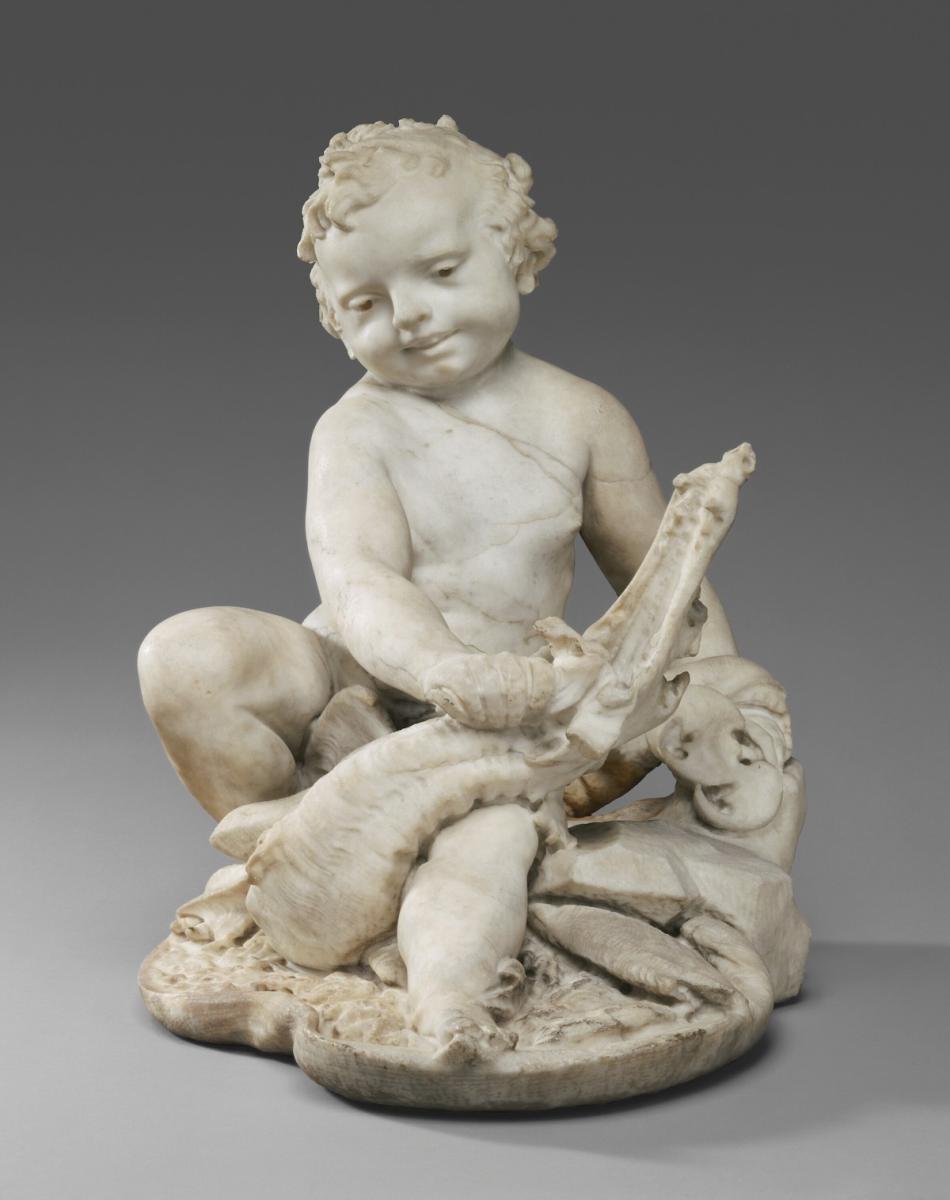 Boy with Dragon, Pietro Bernini (1562–1629) and Gian Lorenzo Bernini (1598–1680), c.1617. Image: The J Paul Getty Museum Los Angeles/87.SA.42
Boy with Dragon, Pietro Bernini (1562–1629) and Gian Lorenzo Bernini (1598–1680), c.1617. Image: The J Paul Getty Museum Los Angeles/87.SA.42
The mighty Hercules, even as a toddler, was pretty impressive. One of his earliest enjoyments, as the story goes, was killing poisonous serpents, and it was with this in mind that father-and-son sculptors Pietro and Gian Lorenzo Bernini got to work. Young Hercules is, rather viciously, snapping a small dragon’s jaw in two with his bare hands.
Hercules’ tussles with snakes are a common theme in Ancient Greek art, particularly when it comes to statues in the Hellenistic period of around 323–30 BC. The theme re-emerged in the 1600s and Hercules’ story is arguably one of the better-known arcs from the Greek pantheon even to this day.
The Getty Centre in Los Angeles now holds this statue, which was first made for the palace of a nobleman who later became the influential Pope Urban VIII. It eventually wound up with King Philip V of Spain in the early years of the 18th century.
Tiny terror
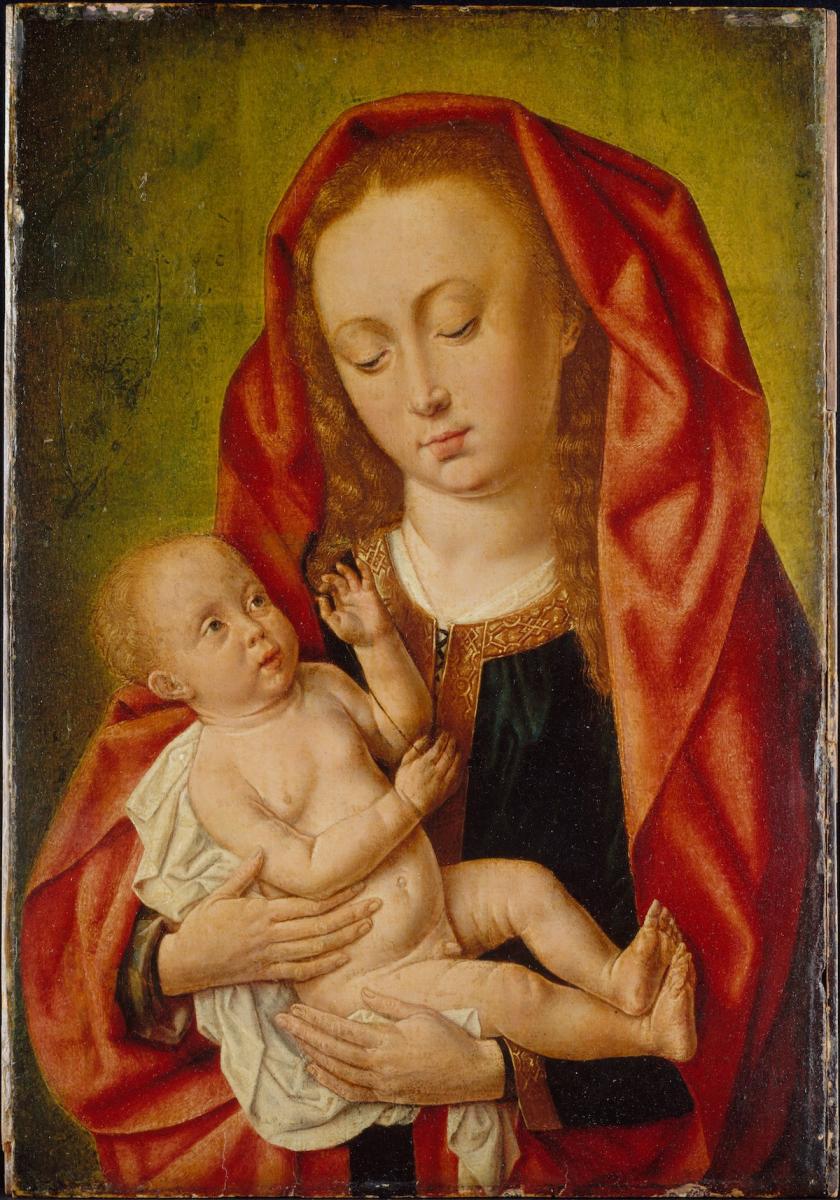 Virgin and Child with a Dragonfly, Master of Saint Giles (c.16th century) c.1500. Image: The Met Collection/Robert Lehman Collection, 1975 1975.1.131
Virgin and Child with a Dragonfly, Master of Saint Giles (c.16th century) c.1500. Image: The Met Collection/Robert Lehman Collection, 1975 1975.1.131
Hercules wasn’t the only son of a god to do battle with a winged monster. At least, not if allegorical narratives are allowed. In this oil painting, a young Jesus snares a dragonfly – a minibeast that was then seen as a stand-in for Satan – with his fingers. The insect is only further trapped by a thin line of thread.
The work is a creation of the enigmatically named Master of Saint Giles. Active in France in the early 16th century or thereabouts, he was perhaps a native painter or a Netherlands-born artist who later moved to Paris or that region. His real name is unknown, and his nickname comes from Max Friedländer – a curator and art historian who reconstructed the Master’s collection from a number of panels and other works.
Dragonflies themselves have been a symbol of more than just the devil at different times in our history and within different communities.
They have been emblems of love, growth, transformation and inner turmoil or pain.
About the Author
Ciaran Sneddon
writes for The Arts Society
JOIN OUR MAILING LIST
Become an instant expert!
Find out more about the arts by becoming a Supporter of The Arts Society.
For just £20 a year you will receive invitations to exclusive member events and courses, special offers and concessions, our regular newsletter and our beautiful arts magazine, full of news, views, events and artist profiles.
FIND YOUR NEAREST SOCIETY
MORE FEATURES
Ever wanted to write a crime novel? As Britain’s annual crime writing festival opens, we uncover some top leads
It’s just 10 days until the Summer Olympic Games open in Paris. To mark the moment, Simon Inglis reveals how art and design play a key part in this, the world’s most spectacular multi-sport competition



